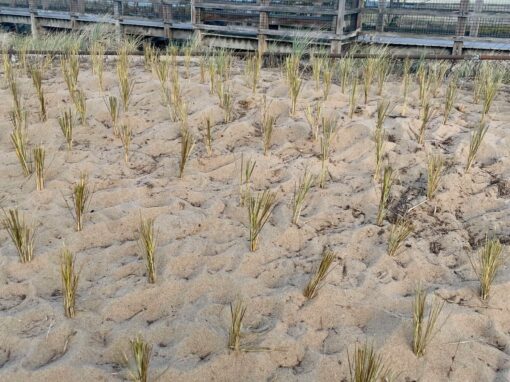On a clear and blustery day in November, we geared up and headed out to Plum Island. With buckets of loamy soil, shakers of nutrients, spades, and bundles of American beach grass, we made our way towards the ocean, stopping at the top of the sand dunes. Over the next two hours, we worked side by side in the dune, digging shallow holes in the sand, dropping in handfuls of soil and nutrients, and placing plugs of dune grass into the cold earth. Once all of our grass bundles had been planted, we stepped back to see our work– a barren dune transformed into a meadow of native plants.
Our coastal dunes play a unique and important role for our communities, improving resilience by acting as a barrier to protect infrastructure against storm surge and flooding. While our barrier beaches are natural and constantly changing systems, robust dunes provide stability. Dune vegetation traps wind-blown sand and allows dunes to gain elevation over time. In addition, the expansive root system of dune plants helps to stabilize sand in place and prevent future erosion. Areas along the dune where natural vegetation has died back can become pathways for storm energy, acting as a funnel for water to move behind the dunes and cause damage to property and infrastructure.
To prevent major dune die-off from occurring, New Hampshire Sea Grant works with coastal communities in New Hampshire and Northern Massachusetts to revegetate and maintain healthy dunes. Their efforts bring in volunteers from coastal communities, local schools, and partner organizations to assist in the process. Taking advantage of the cooler temperatures in the spring and fall, volunteers identify key areas for restoration and conduct regular field days to transplant beach grass to maintain healthy and robust coastal dunes.
Hanna Mogensen, the Coastal Resource Planner and MassBays Regional Coordinator has been active in assisting with dune planting and restoration efforts since 2015. To learn more about how MVPC assists regional efforts like this one, visit our program page. For more information on how you can lend a hand to restore dunes on our coast, check out the Nature Groupie website!

